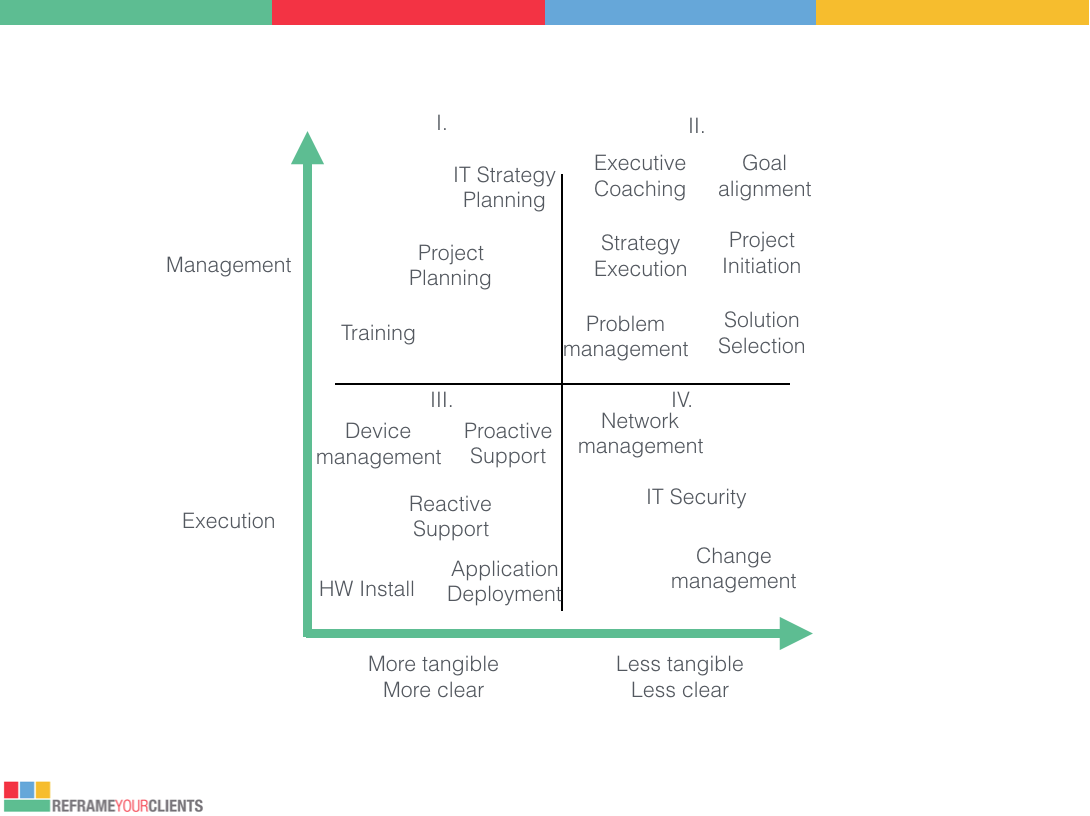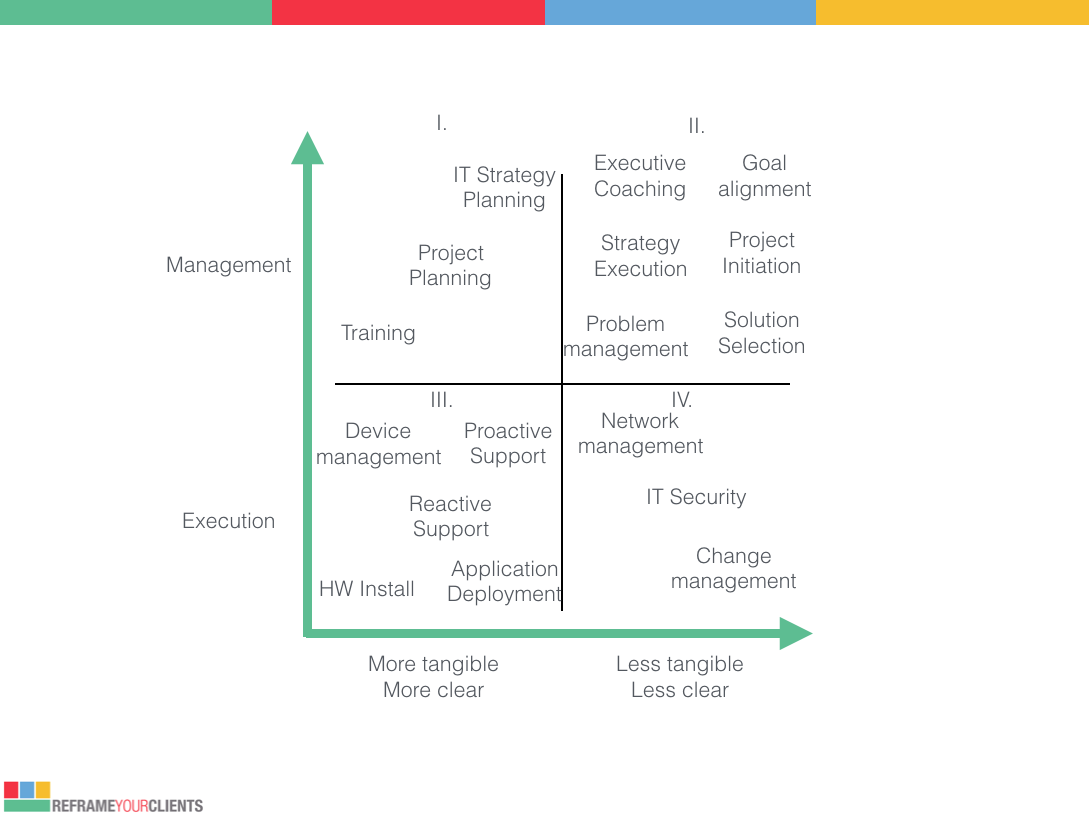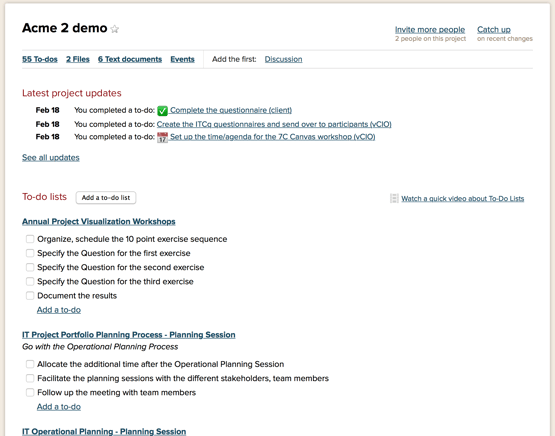

One of the most common and largest hurdles for MSPs is difficulty expressing our value proposition properly, and hence differentiating ourselves.
There are two fundamental aspects of our industry responsible. First is the abstract nature of the proposition. The problems we solve are less tangible, like “competitive edge” or “staying ahead of the curve” rather than “keeping the lights on”. The second is the more managerial and higher level services such as solution selection, and team alignment and integration rather than executable defined processes like device management and remote monitoring.
DO YOU ENGAGE THE PROPER PEOPLE FROM YOUR CLIENT’S ORGANIZATION?
DOWNLOAD OUR STRATEGIC QBR CLIENT MAPPING TOOL
Without a doubt that which is more tangible and more clearly defined is easier to explain, sell and even deliver. We try to answer the question: how we can make our vague and complex services more tangible.
The process below will first identify the different types of services you have, then set up a structure to help manage this process. Then we’re going to demonstrate the practices to enhance different types of less tangible items into a more tangible format. You’ll see how you can actually transform the most difficult to monetize services and make your service portfolio more ready to explain, sell and even deliver.
Let’s go through this short process quickly and see what is going on…
We’ve created a mapping tool to help us visualize the suite of different services we have regarding their type and degree of clarity. The service can be any activity or process you do for your clients.
You can do this easily with your team. Get out your flipchart/white board and sticky notes. If you’re more tech savvy you can use the given PPTx template.
1. Determine the type of service: Management or Execution
On the vertical axis we see a grade of services, management type or execution type.
Managerial type activities include making plans, having meetings, brainstorming new ideas, thinking on the big picture, managing people, aligning your team, and educational initiatives. Professional Services, Account Management, Technical Account Management, and vCIO related activities are typically managerial activities.
The execution part is where you actually implement something, fix things, solve particular IT problems, manage devices, deploy applications and so on. Level I, II, and III support, engineering and solution architect works are execution type positions.
2. Determine whether the service is more tangible or less tangible
On the Horizontal axis you see whether the service is more tangible (clear) or less tangible (less clear).
More tangible services have more physical attributes. These may be attached to a device, an application, a specific deliverable (like an excel sheet, word document), are easy to define and explain. They also include services defined by events or processes such as regular meetings, calls, emails, feedbacks etc.
The less tangible services have no firm definitions, no real processes behind the task, instead consisting mostly of ideas, goals, and vague offerings: starting a project, brainstorming a business problem, evaluating processes and so on.
3. Find the most problematic services
As you can see you’ll often find that Management type services tend toward the less tangible region of the chart while Execution type services are usually more tangible by nature. This means as your clients are pushing you to be more “strategic” or more “business savvy”, what they’re asking is that you deal in services that are inevitably less tangible.
Let’s apply this personally. I bet if you go through your service portfolio you’ll find that the services you call “problematic”, “less profitable”, and “annoying” are on the right hand side - less tangible. It’s no surprise, less tangible services are harder to manage.
Let’s choose the services you want to improve by making them more clear and explainable. Circle them
Now we’re going to apply one or more of the Six Strategies and see which function to move them into the more tangible side.
We’ll use an example here to go through these items. The service that probably eats most of your time is setting up projects. Taking some issues your client has mentioned from discussion to proposal is a long process that we are likely to do without being able to monetize. We’re going to take this service which we give them for free and construct a solid, tangible service with the following strategies.
Strategy 1: Apply a specific deliverable to the service
This first strategy is all about having outcomes with more tangible deliverables. It can be any type of document that demonstrates to both the client and our team member what is expected to be the end result of the service.
Example: Our service is quite intangible at first: “solve a problem”, “manage an issue”, “create a business case”. We can easily turn this into a very specific item with a template. We use the “10 point exercise” for these type of cases. It’s a quick exercise and at the end we’ll have the issues and problems spelled out and prioritized by the team, plus a list of possible next steps as action items. Showing the client such a completed template will bring substance and help them understand the value. Instead of just saying “have a meeting” we are going to deliver tangible evidence of our managerial activities so real value gets recognized.
Strategy 2: Apply specific meetings, workshops to the service
The second strategy creates clarity by applying some sort of specific “workshop” or “meeting” to the service. This is an active strategy of making a vague pursuit more tangible.
Example: We have a slick template for the “10 point exercise” and it gets completed during a “10 point exercise workshop”. We start with vague issues, problems and a misaligned team. We gather them into a workshop and ask everyone their main concerns, issues, problems and perceived opportunities about a given topic. We write it all down, then ask them to distribute 10 points across the answers on the chart. After summarizing points we see together clearly which major items are aligned or misaligned and we can expand on them. Have another round and convert those major items to specific action items. It all takes 30-45 minutes in a workshop that turns a vague input into a specific output.
Strategy 3: Apply a specific process to the service
This third strategy is to attach a very specific process to the service. We can have deliverables and we can have events, but we should also have a set of very specific steps we go through. Standardization like this creates clarity.
Example: We can put on paper the specific process of a 10 point exercise, and present the client with the plan for a workshop, with a briefing in advance. Explain what they can expect as a follow-up, like a template message with the appropriate action items. Even better we can chain together these exercises to encourage a wider vision of these esoteric processes as well. For example the first exercise will be the definition of the problem that leads to different options. We can then manage those options in other 10 point exercises which can lead to continuous solution selection process.
Strategy 4: Apply a cadence to the service
The fourth strategy is going to make the individual service item to a recurring service item. If we give a cadence to a service - such as annual, quarterly, monthly or even weekly - it will tremendously increase clarity of purpose.
Example: Clearly our clients need problems solved and business issue resolution all the time. Every company is working on their bottlenecks, so even when we do ‘fix’ something, something else will come along to keep us busy. Nobody wants to sit back and say “good enough.” In this case we can turn this “Business Issue Management” 10 point exercise of ours into a recurring service. Let’s say we have three 10 point exercises every Quarter to manage different issues with our client’s IT. We use the Quarterly Business Reviews to identify the problems we need to manage and to review the results of exercises.
Strategy 5: Put the service into a clear context
The fifth strategy is to address the problem/solution couplings within a bigger context. This is communicating the function of a given service in context of your overall service portfolio. Ask questions and lead discussions that exhibit your other services working together with this one. If you show the services next to each other you’ll demonstrate their value when playing together nicely. It’ll be seen as a higher level service built up from smaller components designed to fit together.
Example: We have our “Business Issue Management” service now quite nicely defined with templates, workshops, process and cadence. However we do many other things as well and they need many other services too. Let’s list those services in a questionnaire and put some structure around it all. Let’s say this service will be the part of the “Business Alignment Service Type” which falls into virtual CIO services. From that perspective it becomes clear that the virtual CIO has the job of identifying issues and problems of the business and addressing issue management and resolution. Again it gives the service a higher touch and puts it to a context with other activities all critical to a successful structure.
Strategy 6: Put the service into a framework or tool
The sixth strategy is to put the service into a bigger set of services. We touched on that in Strategy 5, with the catalog discovery perspective, and now we’re going to use it as a delivery perspective. If you use tools to group your services together they will communicate more fluidly and foster aligned synergies and notable efficiency.
Example: We have our “Business Issue Management” small service defined among many other services the vCIO can do. Implement the services to a tool that lets us interact with a client for another boost in clarity. For example, use a Customer Management - Project Management tool like Basecamp.com. We can put the 10 point exercises results into it, collaborate with the client and facilitate chat and discussions, and even use it during the Annual Planning. We’re creating a supportive environment where we and our clients are executing services together.

Next Steps:
Now go through your service portfolio and pick some to focus on making more tangible. Apply the strategies one by one and see which work best.
If you can see the process make sense but want to save some time, we’ve applied the six strategies for most of the IT management type services already. It makes Technical Account Management service pretty clear and made vCIO service very sellable and executable from a $1.500 - $5.000 Monthly Recurring Revenue range (with all related vCIO Projects excluded of course).
There are more than 30 services with all six strategies applied with templates, processes, events, cadence, and a sales questionnaire in a customer facing delivery tool.
If you’re interested in these practices, let’s have a quick chat and learn how quickly you can implement them.
DO YOU ENGAGE THE PROPER PEOPLE FROM YOUR CLIENT’S ORGANIZATION?
DOWNLOAD OUR STRATEGIC QBR CLIENT MAPPING TOOL

